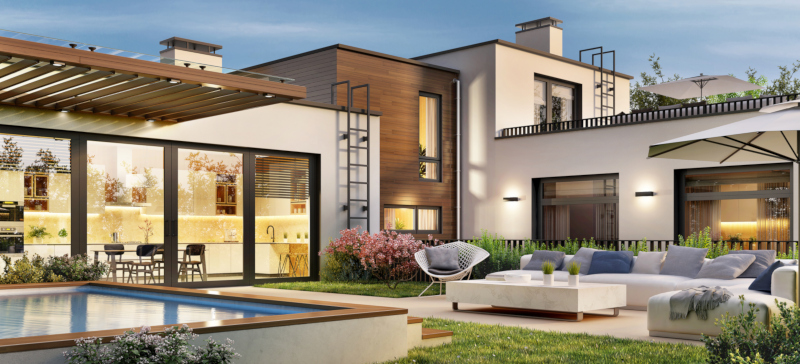Flat roofs have been with us since at least the time of the ancient Egyptians. Their mud-dried brick homes would get very warm after a day of sitting in the hot sun. Residents could use their flat roofs as a sleeping platform, for a cooler night’s sleep.
In Northern California, you’ll find whole neighborhoods of homes designed with flat roofs. There are several developments in San Francisco, and Joseph Eichler’s Marin development projects included Lower and Upper Lucas Valley in San Rafael, the Terra Linda neighborhood in San Rafael, and Strawberry Point, Mill Valley. Eichler also created some custom-designed homes in Belvedere, Tiburon and Kentfield.
Flat roofs aren’t totally flat.
We refer to them as flat, but flat roofs are not completely flat. They are really very-low-slope roofs, to encourage proper drainage. In areas of heavy snowfall, that low slope may not make much difference, as the snowpack can melt slowly. In areas that receive heavy snowfall, homes with flat roofs may be overstressed, as happened to homes in the Tahoe region of California with the heavy snowfalls of early 2023. Luckily, Marin County and San Francisco haven’t faced those conditions.
Why use a flat roof at all?
Flat roofs do have certain benefits over gabled roofs.
- Homes and commercial buildings that feature flat roofs have one big advantage. They are cheaper to construct and install.
The complexities of sloped and steepled roofs make them more costly. Their design also makes them more costly to cover with roofing material since they are not as easy to move around on. They also have many more seams and flashings to worry about. And while flat roofs are perceived to have more drainage problems, gabled roofs have issues with wind damage. As an example, when passing over a gabled surface, the wind can produce leeward suction side pressure that can cause shingles and even entire roofs to be torn off during major storms.
- Flat roofs also offer more square footage. Not surprisingly, residents and commercial businesses are finding more ways to utilize them, from placing solar panels to creating outdoor living spaces. Rooftop decks and the increasingly popular rooftop gardens or living roofs are perfect for flat roofs.
Not every home with a flat roof can accommodate a rooftop deck or garden. A rooftop garden or living roof can add a great deal of weight with the necessary layers. To account for that, the underlying structure may need strengthening to handle the extra load. That means adding additional costs.
- Better accessibility/easier maintenance. If you are a homeowner who likes to maintain your own roof, a flat roof is easier to climb onto and walk along.
When it comes to accessibility and maintenance, the current material used to cover a flat roof makes a difference. So does the age of the roofing material. Older, more brittle roofing material can crack and cause leaks if equipment or boots come down too hard on it. Even so, the tar and gravel roofs have a life of about 30 years, if cared for and maintained.
Newer roofing materials, like polyvinyl chloride, commonly called PVC, is a single-ply white membrane. Thermoplastic polyolefin or TPO is also a single-ply white membrane that reflects heat rather than absorbing it. Both are used in commercial and residential roofing.
If you are exploring building designs for a new home or a live in a home with a flat roof and are looking for ideas of how to utilize it differently, we’d be happy to explore your options.


